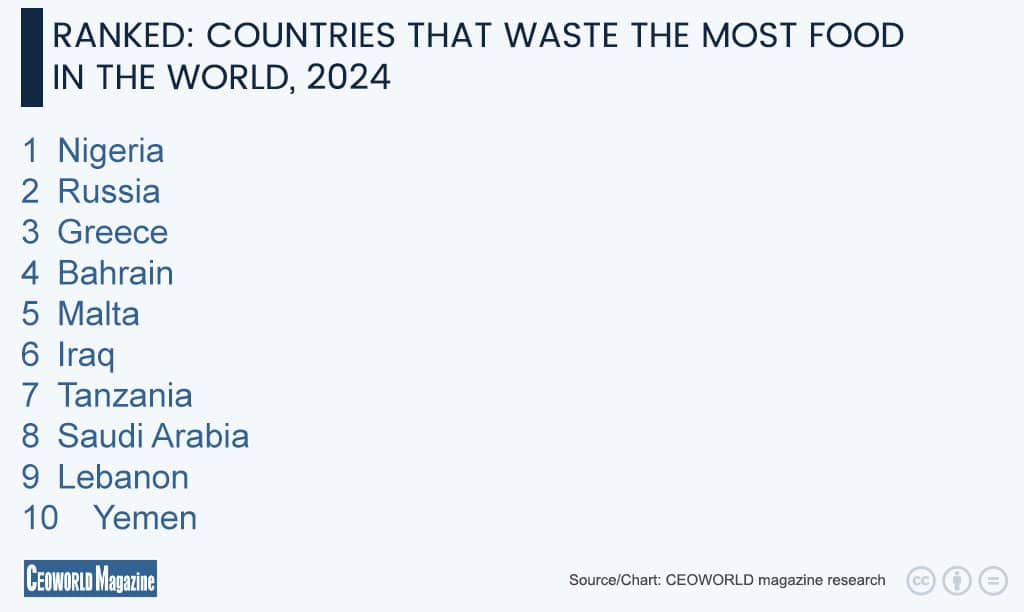Ranked: Countries That Waste the Most Food In The World, 2024

Food waste is a major global problem that has negative impacts on the environment, societies, and economies of countries. According to the United Nations Environment Programme (UNEP) Food Waste Index Report, approximately 931 million tons of food are wasted every year, which accounts for 8 to 10 percent of international carbon emissions related to unconsumed food. The Food Waste Index also revealed that around 17 percent of global food production is thrown away, with households being responsible for 61 percent of this food waste, followed by food service at 26 percent, and the retail industry at 13 percent.
CEOWORLD magazine has published a report that sheds light on the harmful effects of the world’s food waste problem. The publication’s researchers have also highlighted the countries that are the biggest contributors to this international issue. Readers can learn about how countries can work together to tackle this serious problem of global food waste.
How does food waste harm countries?
The UNEP’s Food Waste Index highlights the magnitude of the world’s food waste dilemma. This report suggests that the problem could be more than twofold the size of previous approximations. The Food Waste Index report affirmed that consumer food waste is not an exclusive issue of developed countries as indicated by earlier analysis. Additionally, food storage, production, and transportation losses are not the developing world’s specific concerns.
The Food Waste Index report found that household food waste per capita is the same across lower-middle-income, upper-middle-income, and high-income nations. With these unfavorable realities, food waste reduction is imperative for nutriments squandered increases food insecurity and burdens countries’ waste management systems. Food excess is also a leading contributor to several longstanding environmental concerns, which are pollution, climate change, and biodiversity loss.
Which countries have the highest amount of food waste?
Countries That Waste the Most Food In The World, 2024
| Rank | Waste per Capita (KG) | Annual Waste (tons) | Region | Population | GDP (USD million) | |
|---|---|---|---|---|---|---|
| 1 | Nigeria | 189 | 37.9M | Western Africa | 216,783,400 | 390,002 |
| 2 | Russia | 164 | 2.1M | Eastern Europe | 146,424,729 | 1,862,470 |
| 3 | Greece | 142 | 1.5M | Southeastern Europe (Balkans) | 10,413,982 | 242,385 |
| 4 | Bahrain | 132 | 216.2K | West Asia | 1,577,059 | 44,994 |
| 5 | Malta | 129 | 56.8K | Southern Europe | 519,562 | 20,311 |
| 6 | Iraq | 120 | 4.7M | West Asia | 43,324,000 | 297,695 |
| 7 | Tanzania | 119 | 6.9M | Eastern Africa | 61,741,120 | 84,033 |
| 8 | Saudi Arabia | 105 | 3.6M | West Asia | 32,175,224 | 1,069,437 |
| 9 | Lebanon | 105 | 717.5K | West Asia | 5,490,000 | 37,945 |
| 10 | Yemen | 104 | 3M | West Asia | 31,888,698 | 21,045 |
| 11 | Syria | 104 | 1.8M | West Asia | 22,923,000 | 11,800 |
| 12 | DR Congo | 103 | 8.9M | Central Africa | 95,370,000 | 67,512 |
| 13 | Uganda | 103 | 4.5M | Eastern Africa | 45,562,000 | 52,390 |
| 14 | Mozambique | 103 | 3.1M | Eastern Africa | 32,419,747 | 21,936 |
| 15 | Madagascar | 103 | 2.8M | Eastern Africa | 26,923,353 | 15,763 |
| 16 | Niger | 103 | 2.4M | Western Africa | 25,369,415 | 17,073 |
| 17 | Mali | 103 | 2M | Western Africa | 22,395,489 | 21,309 |
| 18 | Burkina Faso | 103 | 2.1M | Western Africa | 22,185,654 | 20,785 |
| 19 | Malawi | 103 | 1.9M | Eastern Africa | 21,507,723 | 13,176 |
| 20 | Chad | 103 | 1.6M | Central Africa | 17,414,717 | 12,596 |
| 21 | Somalia | 103 | 1.6M | Eastern Africa | 18,143,379 | 11,515 |
| 22 | Guinea | 103 | 1.3M | Western Africa | 13,261,638 | 23,205 |
| 23 | Burundi | 103 | 1.2M | Eastern Africa | 12,837,740 | 3,190 |
| 24 | South Sudan | 103 | 1.1M | Eastern Africa | 13,249,924 | 6,267 |
| 25 | Togo | 103 | 830K | Western Africa | 8,095,498 | 9,111 |
| 26 | Sierra Leone | 103 | 802.4K | Western Africa | 8,494,260 | 3,519 |
| 27 | Central African Republic | 103 | 487.3K | Central Africa | 5,633,412 | 2,760 |
| 28 | Liberia | 103 | 507K | Western Africa | 5,248,621 | 4,347 |
| 29 | Eritrea | 103 | 359.1K | Eastern Africa | 3,748,902 | 2,255 |
| 30 | Gambia | 103 | 241.1K | Western Africa | 2,417,471 | 2,388 |
| 31 | Guinea-Bissau | 103 | 197.3K | Western Africa | 1,781,308 | 1,991 |
| 32 | Australia | 102 | 2.6M | Australasia | 26,461,912 | 1,687,713 |
| 33 | Palestine | 101 | 501.6K | West Asia | 5,483,450 | 18,109 |
| 34 | Georgia | 101 | 403.6K | Eastern Europe | 3,736,400 | 30,023 |
| 35 | Angola | 100 | 3.2M | Central Africa | 33,086,278 | 93,796 |
| 36 | Ivory Coast | 100 | 2.6M | Caribbean | 29,389,150 | 79,430 |
| 37 | Cameroon | 100 | 2.6M | Central Africa | 28,088,845 | 49,262 |
| 38 | Senegal | 100 | 1.6M | Western Africa | 18,275,743 | 31,141 |
| 39 | Zimbabwe | 100 | 1.5M | Eastern Africa | 15,178,979 | 32,424 |
| 40 | Benin | 100 | 1.2M | Western Africa | 12,606,998 | 19,940 |
| 41 | Israel | 100 | 848.4K | West Asia | 9,827,000 | 521,688 |
| 42 | Republic of the Congo | 100 | 535.9K | Central Africa | 6,106,869 | 14,407 |
| 43 | Mauritania | 100 | 450.7K | Western Africa | 4,475,683 | 10,357 |
| 44 | Lesotho | 100 | 211.7K | Southern Africa | 2,306,000 | 2,373 |
| 45 | Eswatini | 100 | 114.3K | Southern Africa | 1,223,362 | 4,648 |
| 46 | Djibouti | 100 | 97K | Eastern Africa | 1,001,454 | 3,873 |
| 47 | Comoros | 100 | 84.7K | Eastern Africa | 758,316 | 1,364 |
| 48 | Cape Verde | 100 | 54.8K | Western Africa | 491,233 | 2,598 |
| 49 | São Tomé and Príncipe | 100 | 21.4K | Central Africa | 214,610 | 674 |
| 50 | Kenya | 99 | 5.2M | Eastern Africa | 51,526,000 | 112,749 |
| 51 | Sudan | 97 | 4.2M | Northern Africa | 41,984,500 | 25,569 |
| 52 | Tajikistan | 97 | 906.2K | Central Asia | 10,077,600 | 11,816 |
| 53 | United Arab Emirates | 95 | 923.7K | West Asia | 9,282,410 | 509,179 |
| 54 | Oman | 95 | 470.3K | West Asia | 5,113,071 | 108,282 |
| 55 | Kuwait | 95 | 397.7K | West Asia | 4,670,713 | 159,687 |
| 56 | Qatar | 95 | 267.7K | West Asia | 2,656,032 | 235,500 |
| 57 | Cyprus | 95 | 113.3K | West Asia | 918,100 | 32,032 |
| 58 | Mexico | 94 | 12M | North America | 129,406,736 | 1,811,468 |
| 59 | Hungary | 94 | 908.7K | Central Europe | 9,597,085 | 203,829 |
| 60 | Turkey | 93 | 7.8M | West Asia | 85,279,553 | 1,154,600 |
| 61 | Jordan | 93 | 939.9K | West Asia | 11,302,000 | 50,022 |
| 62 | Azerbaijan | 93 | 934.9K | West Asia | 10,151,517 | 77,392 |
| 63 | Armenia | 93 | 275.2K | West Asia | 2,981,200 | 24,540 |
| 64 | Mauritius | 93 | 118.6K | Eastern Africa | 1,261,041 | 14,819 |
| 65 | Seychelles | 93 | 9.1K | Eastern Africa | 100,447 | 2,085 |
| 66 | Ethiopia | 92 | 10.3M | Eastern Africa | 107,334,000 | 155,804 |
| 67 | Botswana | 92 | 211.8K | Southern Africa | 2,410,338 | 20,756 |
| 68 | Namibia | 92 | 229.3K | Southern Africa | 2,641,857 | 12,647 |
| 69 | Gabon | 92 | 199.7K | Central Africa | 2,233,272 | 19,319 |
| 70 | Equatorial Guinea | 92 | 124.7K | Central Africa | 1,558,160 | 10,041 |
| 71 | Egypt | 91 | 9.1M | Northern Africa | 104,462,545 | 398,397 |
| 72 | Algeria | 91 | 3.9M | Northern Africa | 45,400,000 | 224,107 |
| 73 | Morocco | 91 | 3.3M | Northern Africa | 37,022,000 | 147,343 |
| 74 | Uzbekistan | 91 | 3M | Central Asia | 36,599,764 | 90,392 |
| 75 | Malaysia | 91 | 2.9M | Southeastern Asia | 33,379,500 | 430,895 |
| 76 | Tunisia | 91 | 1.1M | Northern Africa | 11,850,232 | 51,271 |
| 77 | Papua New Guinea | 91 | 798.8K | Melanesia | 11,781,559 | 31,692 |
| 78 | Kyrgyzstan | 91 | 584K | Central Asia | 7,100,000 | 12,681 |
| 79 | Solomon Islands | 91 | 61K | Melanesia | 734,887 | 1,690 |
| 80 | Vanuatu | 91 | 27.3K | Melanesia | 301,295 | 1,166 |
| 81 | Kiribati | 91 | 10.7K | Micronesia | 121,388 | 297 |
| 82 | Micronesia | 91 | 10.4K | Micronesia | 105,754 | 458 |
| 83 | Luxembourg | 90 | 55.1K | Western Europe | 660,809 | 89,095 |
| 84 | Philippines | 86 | 9.3M | Southeastern Asia | 112,892,781 | 435,675 |
| 85 | Myanmar | 86 | 4.7M | Southeastern Asia | 55,770,232 | 74,861 |
| 86 | Cambodia | 86 | 1.4M | Southeastern Asia | 17,091,464 | 30,943 |
| 87 | Laos | 86 | 619K | Southeastern Asia | 7,443,000 | 14,244 |
| 88 | Timor Leste (East Timor) | 86 | 111.6K | Southeastern Asia | 1,354,662 | 2,023 |
| 89 | France | 85 | 5.5M | Western Europe | 68,373,000 | 3,049,016 |
| 90 | Ghana | 84 | 2.6M | Western Africa | 30,832,019 | 76,628 |
| 91 | Portugal | 84 | 861.8K | Southern Europe | 10,467,366 | 276,432 |
| 92 | Croatia | 84 | 348.1K | Southeastern Europe (Balkans) | 3,855,641 | 80,185 |
| 93 | Andorra | 84 | 6.5K | Southern Europe | 83,523 | 3,692 |
| 94 | San Marino | 84 | 2.9K | Southern Europe | 33,889 | 1,998 |
| 95 | Haiti | 83 | 936.9K | Caribbean | 11,743,017 | 25,986 |
| 96 | Serbia | 83 | 726.2K | Southeastern Europe (Balkans) | 6,641,197 | 75,015 |
| 97 | Bosnia and Herzegovina | 83 | 273.3K | Southeastern Europe (Balkans) | 3,277,082 | 26,945 |
| 98 | Albania | 83 | 238.5K | Southeastern Europe (Balkans) | 2,761,785 | 23,032 |
| 99 | North Macedonia | 83 | 172.5K | Southeastern Europe (Balkans) | 1,832,696 | 15,801 |
| 100 | Montenegro | 83 | 52K | Southeastern Europe (Balkans) | 616,695 | 7,058 |
| 101 | Afghanistan | 82 | 3.1M | Southern Asia | 34,262,840 | 14,939 |
| 102 | North Korea | 81 | 2.1M | Eastern Asia | 25,660,000 | 48,350 |
| 103 | Sweden | 81 | 812.9K | Northern Europe | 10,558,012 | 597,110 |
| 104 | Denmark | 81 | 469.4K | Northern Europe | 5,959,464 | 420,800 |
| 105 | Bolivia | 80 | 922K | South America | 12,006,031 | 46,796 |
| 106 | Honduras | 80 | 780.5K | Central America | 9,745,149 | 33,992 |
| 107 | Nicaragua | 80 | 524.2K | Central America | 6,733,763 | 17,353 |
| 108 | El Salvador | 80 | 516.8K | Central America | 6,884,888 | 35,339 |
| 109 | Singapore | 80 | 465.4K | Southeastern Asia | 5,917,600 | 497,347 |
| 110 | Brunei | 80 | 34.7K | Southeastern Asia | 445,400 | 15,153 |
| 111 | Thailand | 79 | 5.5M | Southeastern Asia | 68,263,022 | 512,193 |
| 112 | Canada | 79 | 2.9M | North America | 40,528,396 | 2,117,805 |
| 113 | Nepal | 79 | 2.2M | Southern Asia | 29,164,578 | 41,339 |
| 114 | Norway | 79 | 423.9K | Northern Europe | 5,533,582 | 546,768 |
| 115 | Bhutan | 79 | 60K | Southern Asia | 770,276 | 2,686 |
| 116 | Palau | 79 | 1.4K | Micronesia | 16,733 | 267 |
| 117 | Nauru | 79 | 850 | Micronesia | 11,680 | 150 |
| 118 | Zambia | 78 | 1.4M | Eastern Africa | 19,610,769 | 29,536 |
| 119 | Mongolia | 78 | 250.2K | Eastern Asia | 3,457,548 | 18,782 |
| 120 | Estonia | 78 | 102.7K | Northern Europe | 1,365,884 | 41,799 |
| 121 | Indonesia | 77 | 20.9M | Southeastern Asia | 279,118,866 | 1,417,387 |
| 122 | United Kingdom | 77 | 5.2M | Western Europe | 67,026,292 | 3,332,059 |
| 123 | Spain | 77 | 3.6M | Southern Europe | 48,345,223 | 1,582,054 |
| 124 | Vietnam | 76 | 7.3M | Southeastern Asia | 100,300,000 | 433,356 |
| 125 | Ukraine | 76 | 3.3M | Eastern Europe | 41,130,432 | 173,413 |
| 126 | Sri Lanka | 76 | 1.6M | Southern Asia | 22,037,000 | 88,309 |
| 127 | Kazakhstan | 76 | 1.4M | Central Asia | 20,000,000 | 259,292 |
| 128 | Libya | 76 | 513.1K | Northern Africa | 6,931,061 | 40,194 |
| 129 | Turkmenistan | 76 | 449.9K | Central Asia | 7,057,841 | 81,822 |
| 130 | Moldova | 76 | 307.4K | Southeastern Europe (Balkans) | 2,512,758 | 16,000 |
| 131 | Lithuania | 76 | 210.3K | Northern Europe | 2,869,660 | 79,427 |
| 132 | Latvia | 76 | 145.3K | Northern Europe | 1,874,700 | 46,668 |
| 133 | Fiji | 76 | 67.4K | Melanesia | 893,468 | 5,511 |
| 134 | Iceland | 76 | 25.8K | Northern Europe | 396,960 | 30,570 |
| 135 | Samoa | 76 | 14.9K | Polynesia | 205,557 | 939 |
| 136 | Tonga | 76 | 7.9K | Polynesia | 100,179 | 547 |
| 137 | Tuvalu | 76 | 878 | Polynesia | 10,679 | 63 |
| 138 | Germany | 75 | 6.3M | Central Europe | 84,607,016 | 4,429,838 |
| 139 | Pakistan | 74 | 15.9M | Southern Asia | 241,499,431 | 340,636 |
| 140 | Chile | 74 | 1.4M | South America | 19,960,889 | 344,400 |
| 141 | Panama | 74 | 313.9K | Central America | 4,337,406 | 82,348 |
| 142 | Uruguay | 74 | 255.9K | South America | 3,444,263 | 76,244 |
| 143 | Trinidad and Tobago | 74 | 103.1K | Caribbean | 1,365,805 | 27,887 |
| 144 | Bahamas | 74 | 28.8K | Caribbean | 397,360 | 13,876 |
| 145 | Barbados | 74 | 21.2K | Caribbean | 267,800 | 6,220 |
| 146 | Antigua and Barbuda | 74 | 7.2K | Caribbean | 100,772 | 1,949 |
| 147 | Rwanda | 74 | 3.9K | Eastern Africa | 13,246,394 | 13,927 |
| 148 | Saint Lucia | 74 | 2.8K | Caribbean | 178,696 | 2,469 |
| 149 | Argentina | 72 | 3.2M | South America | 46,654,581 | 621,833 |
| 150 | Peru | 72 | 2.4M | South America | 33,396,698 | 264,636 |
| 151 | Venezuela | 72 | 2.1M | South America | 28,302,000 | 92,210 |
| 152 | Ecuador | 72 | 1.3M | South America | 16,938,986 | 118,686 |
| 153 | Guatemala | 72 | 1.3M | Central America | 17,602,431 | 102,765 |
| 154 | Dominican Republic | 72 | 777.8K | Caribbean | 10,760,028 | 120,629 |
| 155 | Cuba | 72 | 820.9K | Caribbean | 11,089,511 | 107,528 |
| 156 | Switzerland | 72 | 616K | Western Europe | 8,931,306 | 905,684 |
| 157 | Paraguay | 72 | 510.3K | South America | 6,109,644 | 44,142 |
| 158 | Costa Rica | 72 | 365.6K | Central America | 5,262,225 | 85,590 |
| 159 | Jamaica | 72 | 213.6K | Eastern Asia | 2,825,544 | 18,761 |
| 160 | Guyana | 72 | 56.7K | South America | 743,699 | 16,329 |
| 161 | Suriname | 72 | 42.1K | South America | 616,500 | 3,539 |
| 162 | Saint Kitts and Nevis | 72 | 13.2K | Caribbean | 47,195 | 1,069 |
| 163 | Grenada | 72 | 8.1K | Caribbean | 112,579 | 1,306 |
| 164 | Saint Vincent and the Grenadines | 72 | 8K | Caribbean | 110,872 | 1,039 |
| 165 | Dominica | 72 | 5.2K | Caribbean | 67,408 | 697 |
| 166 | Liechtenstein | 72 | 2.7K | Central Europe | 39,724 | 6,608 |
| 167 | Monaco | 72 | 2.8K | Western Europe | 39,050 | 8,596 |
| 168 | Iran | 71 | 5.9M | West Asia | 84,038,000 | 366,438 |
| 169 | South Korea | 71 | 3.7M | Eastern Asia | 51,439,038 | 1,709,232 |
| 170 | Hong Kong (China) | 71 | 531K | Eastern Asia | 7,498,100 | 385,546 |
| 171 | Macau (China) | 71 | 45.7K | Eastern Asia | 681,300 | 38,480 |
| 172 | Maldives | 71 | 37.7K | Southern Asia | 382,751 | 6,977 |
| 173 | Colombia | 70 | 3.5M | South America | 52,215,503 | 363,835 |
| 174 | Qatar | 70 | 1.4M | West Asia | 2,656,032 | 235,500 |
| 175 | Czech Republic | 70 | 746.9K | Central Europe | 10,882,235 | 335,243 |
| 176 | Slovakia | 70 | 381.3K | Central Europe | 5,426,468 | 133,044 |
| 177 | Belarus | 68 | 646.4K | Eastern Europe | 9,200,617 | 68,864 |
| 178 | Bulgaria | 68 | 478.7K | Southeastern Europe (Balkans) | 6,447,710 | 103,099 |
| 179 | Italy | 67 | 4.1M | Southern Europe | 58,919,345 | 2,186,082 |
| 180 | Bangladesh | 65 | 10.6M | Southern Asia | 169,828,911 | 446,349 |
| 181 | Finland | 65 | 361.9K | Northern Europe | 5,572,545 | 305,689 |
| 182 | China | 64 | 91.6M | Eastern Asia | 1,409,670,000 | 17,700,899 |
| 183 | Japan | 64 | 8.2M | West Asia | 124,240,000 | 4,230,862 |
| 184 | New Zealand | 61 | 291.8K | Australasia | 5,223,100 | 249,415 |
| 185 | Brazil | 60 | 12.6M | South America | 203,062,512 | 2,126,809 |
| 186 | United States | 59 | 19.4M | North America | 335,893,238 | 26,949,643 |
| 187 | Poland | 56 | 2.1M | Central Europe | 37,667,000 | 842,172 |
| 188 | Ireland | 55 | 267.1K | Western Europe | 5,281,600 | 589,569 |
| 189 | Belize | 53 | 20.6K | Central America | 441,471 | 3,218 |
| 190 | India | 50 | 68.8M | Southern Asia | 1,392,329,000 | 3,732,224 |
| 191 | Netherlands | 50 | 854.9K | Western Europe | 17,590,000 | 1,092,748 |
| 192 | Belgium | 50 | 576K | Western Europe | 11,801,722 | 627,511 |
| 193 | South Africa | 40 | 2.3M | Southern Africa | 62,027,503 | 380,906 |
| 194 | Austria | 39 | 349.2K | Central Europe | 9,154,514 | 526,182 |
| 195 | Slovenia | 34 | 71.1K | Southeastern Europe (Balkans) | 2,120,937 | 68,394 |
| 196 | Romania | 33 | 4.9M | Southeastern Europe (Balkans) | 19,051,562 | 350,414 |
CEOWORLD magazine’s researchers discovered that the food waste problem is worse than previously thought. They found the following information about the world’s top contributors to this critical international dilemma.

The data above shows the approximate yearly food waste per contributor, with China leading at 91 million tons. The exact methodology for determining the estimates is different from country to country. CEOWORLD magazine’s researchers have the following explanation for the figures: Analysts point to China’s most populated country status as to why it has the highest gross amount of food waste at over 91 million tons a year. The Asian country’s population at the time of this writing is exactly 1,425,392,198 people.
India trails behind China when it comes to gross food waste amount, surpassing a staggering 68 million tons annually. Similar to Asia’s most populated country, the exactly 1,436,032,238 people to date in India are seen as the reason for the overwhelming amounts of unconsumed food in the South Asian country. The United States dominates the world when it comes to food production, export, and technology. It is also the world’s largest food consumer. With these facts, the United States’ gross food waste amount exceeds 19 million tons yearly.
CEOWORLD magazine’s researchers discovered that Japan’s nature of being a densely populated land is pointed to as the main reason for its whopping food waste count. This Asian country’s gross food waste total is more than 8 million tons a year. Germany lands on the list above of the countries with the highest amount of food waste, thanks to its status as an industrialized country and its relatively large size like other European territories. The gross food excess amount in this country is over 6 million tons annually.
France is renowned for its people’s love of food and being home to iconic baked products like the croissant, pain au chocolat, tarte aux framboise, and macarons. These attributes of the European country unsurprisingly land it on the list of countries with the highest amount of food waste, with more than 5 million tons in gross tally per year. Like many developed countries in Europe where food technology and production are state-of-the-art, the United Kingdom is also not immune to the global food waste problem. The gross food excess amount in this country surpasses 5 million tons yearly.
Russia’s land area and population of more than 144 million people at the time of writing this report are linked to its enormous amount of food waste. In this country, over 4 million tons of food excess has been recorded. The Spanish culture of love for food and social gatherings is seen as the primary reason why Spain is a top contributor to the world food waste dilemma. The gross food excess amount in this Southwestern European country is greater than 3 million tons annually, and much of this waste is linked to social celebrations.
CEOWORLD magazine’s researchers found that Australia may be among the global leaders in green energy conservation initiatives, yet it is also a main contributor to the international food waste issue. The largest country in Oceania has over 2 million tons of food getting squandered a year. The top 10 countries on the list above are the world’s developed countries, emerging economies, and the most populated. With their advancement in food technology and production, land area, and billions of people, they have become the world’s main causes of the food waste dilemma.
How can the world’s top food waste contributors assist in resolving the problem?
CEOWORLD magazine believes the ten countries that have the highest amount of food waste per year can also be the solution and the role model for the rest of the world, considering their wealth and advancement in technology. These nations can follow the Food Waste Index’s recommendation of governments utilizing the report’s methodology for gauging food waste at retail, household, and food service levels.
In this way, these countries can guide their national strategies for food excess prevention and track their progress towards the 2030 United Nations Sustainable Development Goal. The latter commits nations to halving the per capita international food waste at all levels. Furthermore, food waste can be reduced by encouraging consumers to compost food scraps to return the nutrients to the earth and decrease their carbon footprint. Sharing any surplus food or donating it via informal sharing with family and friends and food banks is also helpful.
Consumers are recommended to purchase local produce. In this manner, they can help combat pollution through the reduction of food delivery distances. Finally, taking smaller food portions and using leftovers as added ingredients to another meal can diminish food waste. These significant steps can have considerable benefits to countries’ economies, societies, and environment in the long run.
Have you read?
Revealed: Highest-paid college football coaches, 2024.
Revealed: These are the Deadliest Cars you can drive in the US, 2024.
Revealed: Words that weren’t in use before the 1990s but are now commonly used.
Ranked: Countries with the lowest petrol prices, 2024.
Revealed: The World’s Safest Airlines To Fly In 2024.
Add CEOWORLD magazine to your Google News feed.
Follow CEOWORLD magazine headlines on: Google News, LinkedIn, Twitter, and Facebook.
Copyright 2024 The CEOWORLD magazine. All rights reserved. This material (and any extract from it) must not be copied, redistributed or placed on any website, without CEOWORLD magazine' prior written consent. For media queries, please contact: info@ceoworld.biz











